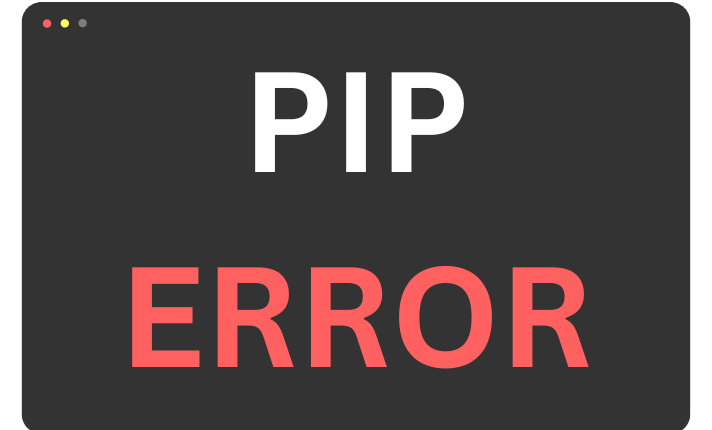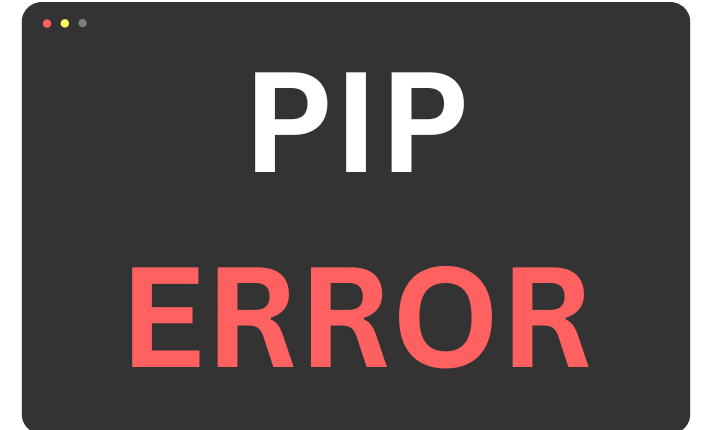Installing and updating packages is a common task for developers and Python users. However, after October 2020, there may be instances where you encounter errors during these processes.

Table of Contents
- Overview of pip
- Changes in pip after October 2020
- Understanding dependency conflicts
- Resolving dependency conflicts
- Preparing for the changes
- Future implications and benefits
- Conclusion
- FAQs
The reason behind these errors lies in the changes made to the way pip resolves dependency conflicts. This article aims to provide a comprehensive understanding of this issue and how you can overcome it.
Overview of pip
Before diving into the changes, let’s briefly understand what pip is and its role in package installation and management. Pip is the package installer for Python, allowing users to easily install and manage third-party packages. It simplifies the process by handling package dependencies, ensuring that all required components are installed correctly.
Changes in pip after October 2020
Starting from October 2020, pip has implemented significant changes in the way it resolves dependency conflicts. Previously, when conflicts occurred, pip would attempt to find a compatible version by analyzing the available package versions and their requirements. However, this approach had limitations and sometimes resulted in incorrect or incompatible combinations.
To address this issue, pip has adopted a new approach known as “resolving via the solver.” This method uses a mathematical solver algorithm to find the best combination of package versions that satisfy all dependencies. By leveraging this solver, pip aims to provide more accurate and reliable resolution of dependency conflicts.
Here’s an example to illustrate the changes. Let’s say you have two packages, packageA and packageB, which require conflicting versions of dependencyX:
# Old approach (before October 2020)
pip install packageA # Installs dependencyX v1.0
pip install packageB # Upgrades dependencyX to v2.0, breaking packageA
# New approach (after October 2020)
pip install packageA # Installs dependencyX v1.0
pip install packageB # Finds a compatible version of dependencyX (e.g., v1.5), ensuring both packages work correctlyAs you can see, the new approach resolves the conflict by finding a compatible version (v1.5) that satisfies the requirements of both packageA and packageB.
Understanding dependency conflicts
Dependency conflicts occur when different packages require conflicting versions of the same package or its dependencies. These conflicts can arise due to various reasons, such as incompatible dependencies, version constraints, or overlapping requirements. Failing to resolve these conflicts properly can lead to errors, crashes, or unexpected behavior in your Python projects.
To better understand the concept, consider the following example. Suppose you have two packages, packageX and packageY, where packageX requires dependencyA version 1.0, and packageY requires dependencyA version 2.0:
# Dependency conflict example
pip install packageX # Installs dependencyA v1.0
pip install packageY # Upgrades dependencyA to v2.0, breaking packageXIn this case, installing packageY breaks the compatibility with packageX because they require different versions of dependencyA.
Resolving dependency conflicts
To resolve dependency conflicts effectively, it is crucial to follow certain techniques and best practices. Here are some steps you can take:
- Identifying conflicts: Analyze error messages or use tools like
pipdeptreeorpip-checkto identify conflicting dependencies in your project. - Adjusting version constraints: If possible, update version constraints in your project’s
requirements.txtorsetup.pyfile to allow for compatible versions of the conflicting packages. For example, ifpackageArequiresdependencyX >= 1.0andpackageBrequiresdependencyX < 2.0, you can set the constraint todependencyX >= 1.0, < 2.0to allow compatible versions. - Upgrading packages: Check if there are newer versions of the conflicting packages that resolve the compatibility issues. Upgrading to these versions can often help in resolving conflicts.
- Manual installation: In some cases, you may need to manually install specific versions of packages to ensure compatibility. You can use the
--versionflag withpipto install a specific version of a package. For example:pip install packageX==1.0to install version 1.0 ofpackageX. - Virtual environments: Consider using virtual environments to isolate your project’s dependencies. Virtual environments provide a clean environment where you can install specific versions of packages without affecting the global Python installation.
By following these techniques, you can effectively identify and resolve dependency conflicts, ensuring smooth installation and update processes for your Python packages.
Preparing for the changes
To adapt to the changes in pip and minimize the impact on your projects, it is essential to be prepared. Here are some guidelines for both package developers and users:
For package developers:
- Update your package metadata: Ensure that your package metadata accurately reflects the dependencies and version constraints required for your package to function properly.
- Test compatibility: Test your package with different versions of dependencies to ensure compatibility. This will help you identify and address any potential conflicts before they arise.
- Provide clear documentation: Clearly document the required versions and any potential conflicts that may occur when using your package. This will help users understand and resolve any issues that may arise.
For package users:
Update pip: Make sure you have the latest version of pip installed. You can update pip by running the command pip install --upgrade pip.
- Update packages: Regularly update your packages to ensure you have the latest versions and any bug fixes or compatibility improvements.
- Check package compatibility: Before installing or updating packages, check the compatibility requirements and potential conflicts. This can be done by reviewing package documentation or using tools like
pip-checkorpipdeptree. - Virtual environments: Consider using virtual environments to isolate your project dependencies. This can help prevent conflicts between different projects and provide a clean environment for package installations.
By following these recommendations, both developers and users can be better prepared to handle the changes in pip and minimize any potential errors or conflicts during package installations or updates.
Future implications and benefits
While these changes may initially introduce some challenges, they also bring long-term benefits to the Python package ecosystem. By adopting the new approach of resolving dependency conflicts, pip aims to improve the stability, reliability, and accuracy of package installations and updates.
With the solver algorithm, developers can have more confidence that the correct combination of package versions will be installed, reducing the chances of compatibility issues. This, in turn, leads to enhanced project stability and smoother collaboration between developers.
For users, the changes mean fewer errors and conflicts when installing or updating packages, resulting in a more streamlined development process. Additionally, the new approach encourages package developers to provide clear and accurate metadata, leading to better package documentation and easier management of dependencies.
In summary, while the changes in pip may require some adjustment, they ultimately contribute to a more robust and efficient package management system, benefiting both developers and users.
Conclusion
The changes in pip’s approach to resolving dependency conflicts after October 2020 bring improvements to the stability and reliability of package installations and updates. By adopting a solver algorithm, pip aims to provide more accurate and precise resolution of conflicts, minimizing errors and compatibility issues and enhancing the overall package management experience.
It is important for package developers to update their package metadata, test compatibility with different versions of dependencies, and provide clear documentation. By doing so, they can ensure that users have the necessary information to resolve any potential conflicts and use their packages effectively.
For users, keeping pip updated to the latest version is crucial. Regularly updating packages and checking compatibility requirements can help identify and address any conflicts before they become problematic. Utilizing virtual environments can provide an isolated environment for projects, reducing the chances of conflicts between packages.
These changes in pip’s dependency resolution approach have future implications that will benefit the Python community. The improved stability and accuracy of package installations and updates will result in smoother development processes and increased project reliability. Developers can have more confidence in the compatibility of their packages, while users will experience fewer errors and conflicts during package management.
In conclusion, the changes in pip’s dependency resolution approach after October 2020 require developers and users to be prepared and follow best practices. By updating package metadata, testing compatibility, providing clear documentation, and staying updated with the latest version of pip, the impact of dependency conflicts can be minimized. Ultimately, these changes contribute to a more robust and efficient Python package ecosystem, ensuring a better development experience for all.
FAQs
1. What is pip?
- Pip is the package installer for Python that allows users to easily install, manage, and update third-party packages.
2. Why do dependency conflicts occur?
- Dependency conflicts occur when different packages require conflicting versions of the same package or its dependencies. Resolving these conflicts is crucial to maintain project stability.
3. How can I identify and resolve dependency conflicts?
- You can identify conflicts by analyzing error messages or using tools like
pipdeptreeorpip-check. To resolve conflicts, adjust version constraints, upgrade packages, or install compatible versions manually.
4. Will the changes in pip affect existing packages?
- While the changes may require some adjustments, existing packages can be updated to ensure compatibility and benefit from the improved resolution of dependency conflicts.
5. Is it necessary to update pip immediately after the changes?
- It is not necessary to update pip immediately, but it is recommended to regularly update to the latest version to ensure you have the latest bug fixes, security enhancements, and new features.
This link provides additional information and resources related to managing and resolving dependency conflicts in Python packages. It can further assist you in understanding and addressing any challenges that may arise during the installation or update process.


